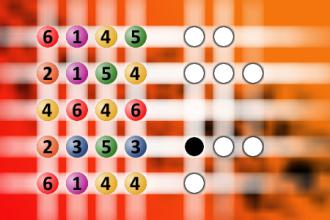Which is a winning combination of digits?
The computer chose a secret code (sequence of 4 digits from 1 to 6). Your goal is to find that code. Black circles indicate the number of hits on the right spot. White circles indicate the number of hits on the wrong spot.Correct answers: 2
#brainteasers #mastermind

Lumberyard
Jon's working at the lumberyard, pushing a tree through the buzz saw, and accidentally shears off all ten of his fingers. He goes to the emergency room.
The doctor says, "Yuck! Well, give me the fingers, and I'll see what I can do."
Jon says, "I haven't got the fingers."
The doctor says, "What do you mean, you haven't got the fingers? It's 1999. We've got microsurgery and all kinds of incredible techniques. I could have put them back on and made you like new. Why didn't you bring the fingers?"
Jon says, "Well, sh*t, Doc, I couldn't pick 'em up."

